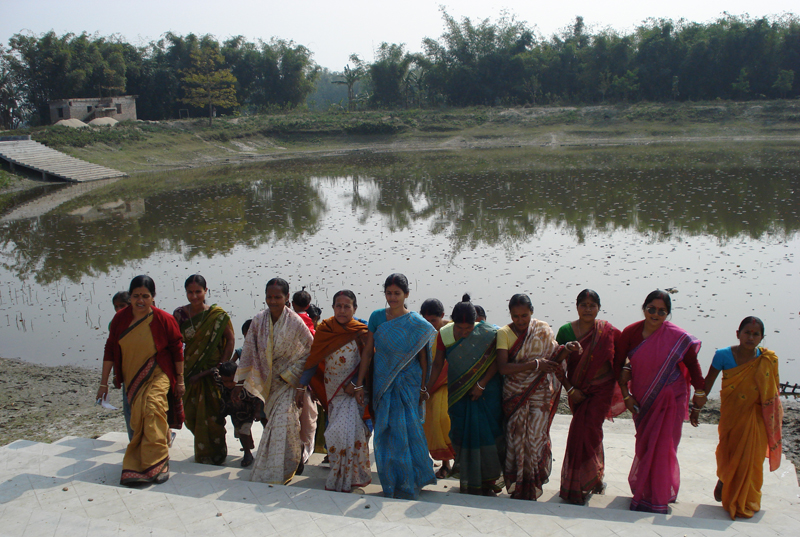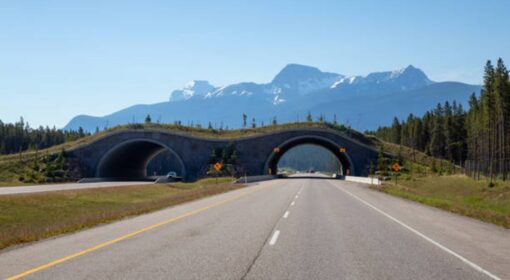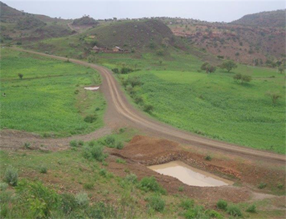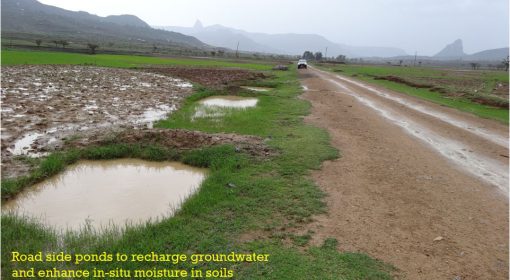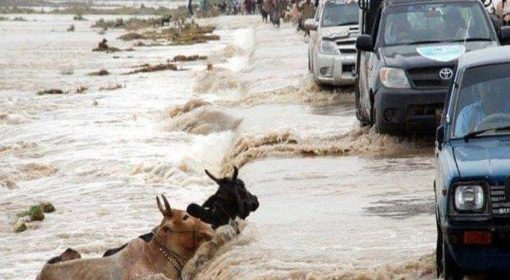On the Road with Resilience
Posted by Kifle Wolderegay, Rajeshwar Mishra and Frank van Steenbergen
December 6, 2016
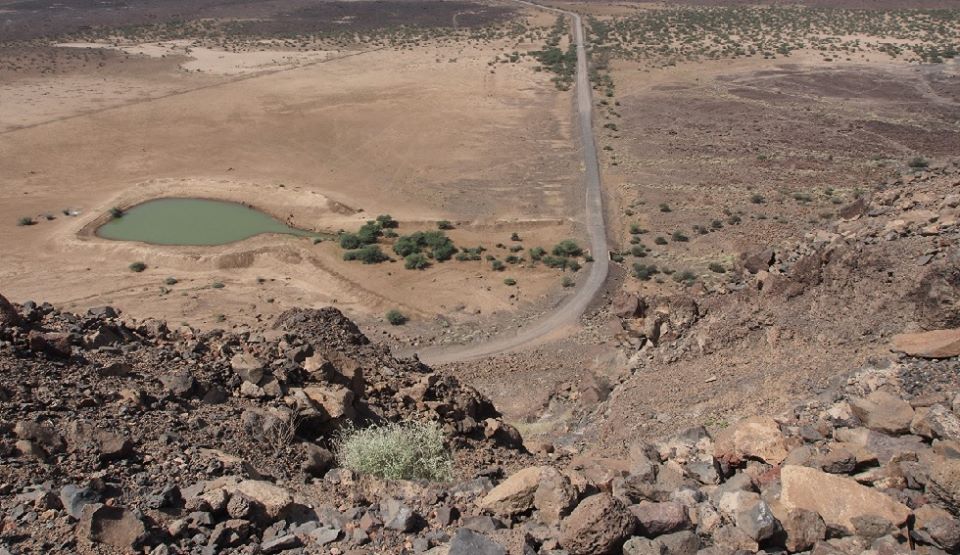
It is a simple concept: resilience, improving existing systems, making them more productive and stronger, better able to deal with shocks and even converting problems into opportunities.
Resilience is a departure from the concept of sustainability that wants to preserve what is there or sometimes what has been temporarily created – and as such is often conservative by character. Yet development is a lifelong project, even though nature and culture are always changing. There is no cut-off date by which all is secured against all that comes after. It is here that resilience comes in – working with existing systems – make them more robust, fair and productive to provide inclusive services and reduce the vulnerability of those that live by them. What are these existing systems? They are the norms and values we live by, the communities and networks we are part of, the landscapes that support us and the governments that we deem legitimate.
To illustrate the point, here are two examples. First is the experience of the North Bengal Terai Women’s Federation (Uttar Banga Teria Mahila Samiti in Bangla) in India. This federation started small in 1998 – as many things – on the strength of thirty women groups with 25 members each, organized and supported by a rural development project. The formula was for women groups to save money for several months, after which the collective saving would be doubled by the project and support would be given to start a joint economic activity. Though this programme was popular and caused the initiation of some interesting joint economic activities, the arrangement was judged not to be sustainable, as it depended very much on the incentive of the doubled savings.
A new course of action was taken whereby there would no longer be the financial bonus. In spite of this there was continued interest from women to create groups. There were two important reasons – to be united and strong enough in undertaking an economic activity; and in some cases to form a joint front in case of domestic abuse. To form a group an aspiring group would visit an existing group, take lessons from there and develop their own group. The interest was high and then federations were formed at district level with regular meetings and exchanges between groups, all with funding from within the groups themselves. In four years, 300 groups come into being with an average 25 members each; with almost no external facilitation. Since then, the women federation has grown and grown. Now, ten years hence, it counts 600 groups with an average 15 members each and is a hallmark of a self-evolving resilient organization. The woman who was the initial (and only) project facilitator is now employed by the Federation and acts as the Secretary. The Women Federation is a main conduit and interface for development programs in the region – be it on functional literacy, rural banking or agricultural development.
The success of the Women Federation was the reliance on strong norms and values – solidarity and ability to do well; rather than being dependent on temporary incentives, in this case a doubling of savings. The Federation is driven by pride and compassion – something sorely missed in much of development work, which, rather than reverting to norms and values has become immoral and procedural, often relying on complex cost contribution arrangements. The second success factor was the reliance on communities to self-organize and self-evolve. It was the women groups that organized themselves, triggered and inspired by the federation and annual conventions where they would meet, learn, compare, cooperate and be inspired. Contrast this with the reliance on external social mobilization that unfortunately has become such strong feature of ‘community development’ – with social organizers organizing village meetings, making visions and plans on flip charts, creating their own dependent constituencies. The image that comes to the mind is that of many signposts of NGOs – all competing for attention. That is dependency and not resilience.
The second example comes from the Global Resilience Partnership (GRP) and concerns the program to systematically convert roads into more than just transport corridors; to make them instruments of climate resilience and improved water management. The program started in 2014 in Ethiopia after a research project probed the opportunities to use roads for harvesting water. The point of departure was that the construction of roads is the single major intervention on the surface hydrology and landscapes. Road bodies block the flow of water, they concentrate it in a limited number of places and during heavy rainfall some roads become like drains careering water downstream. This unfortunate practice brings widespread negative impacts: erosion along roads, devastating local floods caused by road drainage, and water logging elsewhere. Several studies have established that along ten kiilometers of road the number of problems spots range between 8 to 25. In Ethiopia, for instance, the lifespan of the Grand Renaissance Dam could be severely shortened by the sedimentation triggered by road construction (and the massive erosion that comes with it) in the upper catchment of the Dam.
However these problems can be turned around by systematically managing water along the roads and turning a problem into an asset. The run-off of water along roads in dry areas can be used to fill storage ponds, recharge groundwater, irrigate land and pastures. In other areas roads can be used to manage water levels in coastal areas, serve as flood shelters, control sand dune movement or influence fish movement.
Managing water with roads is also a superior approach than the current thinking on making roads more climate resilient by making the specification ever heavier and more weather-proof but also unaffordable. When the idea of road water harvesting was first introduced in Tigray in Ethiopia, the uptake by the different government departments was enormous. It was immediately incorporated in the intensive watershed programs whereby entire landscapes are covered by mass mobilization campaigns and safety net programs. From there, the road water harvesting activities spread to three more large regions in Ethiopia – improving water availability for an estimated 1 Million people in the 2016 campaigns for instance. Support from the GRP has consisted of documentation, motivational training to the large implementing organizations, monitoring and preparing guidelines with the Ethiopian Roads Authority and building a learning alliance.
The strength of the program has been that it was implemented at scale immediately through an effective and legitimate government. This has a dynamic of its own – for instance that of a program happening in so many places that it is hard to keep track, but also of unleashing enormous creativity in finding local solutions.
In fact, the entire water harvesting program in Tigray, Amhara and other parts of Ethiopia has been successful in transforming degraded landscapes into productive water holding assets and making them more resilient. The watershed programme has a long history. Up to 2005 it had a strong focus on sustainability but was inherently also very conservative – focussing on soil conservation and erosion control. This made sure land degradation problems did not get worse but at the same things also did not get exponentially better. Over the years the approach changed and water harvesting was added to the repertoire with a myriad of new or modified techniques (contour bunds, bench terraces, eyebrows, infiltration trench, storage and recharge ponds). This started to make a huge difference. Not only was soil erosion reduced but water was harvested and kept available. As a result of the massive watershed programs, groundwater tables started to increase and it become possible to develop shallow wells, where they had never been groundwater before. The landscapes were not just preserved but they were improved and formed the basis for more prosperity and resilience against shocks. The big test case was the El Nino Year of 2015 – more severe in terms of drought even than the 1984 Year of Disaster with the epic famine. This time there was no political conflict as in 1984 but also importantly the Tigray landscapes had been transformed and one of the worst droughts on record passed without a human victim.
The intensive watershed activities in Amhara and Tigray have had another effect. The retention of water in the landscape and the overall re-greening changed the micro-climate. There is better soil moisture – which secures water to crops but also ensures more natural nitrogen fixation because the soil biota are more active. With better soil moisture, soil and air temperatures are also regulated – leading to better germination of crops for instance. Further the overall re-greening has reduced the he desiccating and eroding effect of wind, and is producing more local rainfall. This entire chain of effects is leading to more resilient and productive micro-climates.
This presents a new angle to coping with climate change. At present there are two main climate change strategies: mitigation (avoiding that the problem gets worse) and adaptation (making the best of the consequences). But we believe there is a third and probably equally strong strategy – systematically improving the micro-climate at landscape level. The strength of this third strategy is that it can taken up locally and is not dependent on global processes but creates local wins. It will ensure that local areas are less affected by global change, but that better use is made of these, at the same increasing the productivity and resilience.
